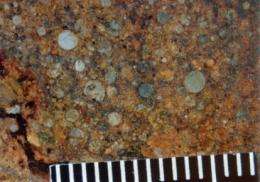November 2, 2012 report
Researchers use new technique to date CAIs and chondrules

(Phys.org)—Researchers working out of the University of Copenhagen have published a paper in the journal Science in which they claim that a new method of dating chondrules and calcium-aluminum–rich inclusions (CAIs) is more accurate than previous methods. Their dating method produces results that contradict earlier findings that have suggested that chondrules formed up to 2 million years later than CAIs; instead they say, the two materials found in meteorites formed at roughly the same time.
Scientists believe that the sun and all of its orbiting bodies formed from a spinning disk approximately 4.6 billion years ago. Theory suggests the sun came first, initially surrounded by a cloud of dust and gas that over time became the planets, comets and asteroids. But for that to happen, some bit of material had to bind together first, and researchers believe two of them – chondrules and CAIs – are still present in modern meteorites. Up till now however, there has been disagreement among researchers regarding the age of such materials found in meteorite samples that have struck the Earth.
Prior attempts to measure the age of materials in meteorite samples involved using techniques to discern how much aluminum 26 was present. The thinking was that differences in the levels of the isotope indicated different ages. The problem with this methodology, the new team points out, is that it ignores the possibility that objects forming in different locations might naturally have different amounts of the isotope in them.
Their new technique involves isolating small amounts of lead found in a sample and then measuring the isotopic composition of both it and uranium and then calculating the age of the material using the known rate of decay of uranium. Using this method, the team calculated that both materials in a meteorite sample were approximately 4.56730 billion years old. And because their method is so precise they say the error rate of their technique is just 160,000 years.
If the new method for calculating the age of chondrules and CAIs is adopted by the scientific community it will likely mean revising some ideas regarding the makeup of the early universe.
More information: The Absolute Chronology and Thermal Processing of Solids in the Solar Protoplanetary Disk, Science, 2 November 2012: Vol. 338 no. 6107 pp. 651-655 DOI: 10.1126/science.1226919
ABSTRACT
Transient heating events that formed calcium-aluminum–rich inclusions (CAIs) and chondrules are fundamental processes in the evolution of the solar protoplanetary disk, but their chronology is not understood. Using U-corrected Pb-Pb dating, we determined absolute ages of individual CAIs and chondrules from primitive meteorites. CAIs define a brief formation interval corresponding to an age of 4567.30 ± 0.16 million years (My), whereas chondrule ages range from 4567.32 ± 0.42 to 4564.71 ± 0.30 My. These data refute the long-held view of an age gap between CAIs and chondrules and, instead, indicate that chondrule formation started contemporaneously with CAIs and lasted ~3 My. This time scale is similar to disk lifetimes inferred from astronomical observations, suggesting that the formation of CAIs and chondrules reflects a process intrinsically linked to the secular evolution of accretionary disks.
Journal information: Science
© 2012 Phys.org




















